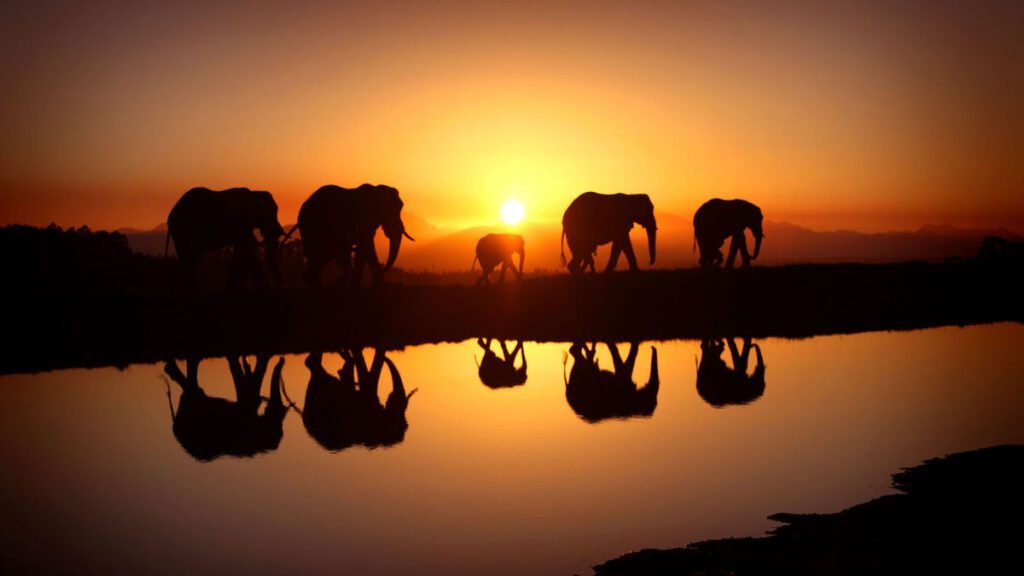Africa’s wildlife isn’t confined by borders, and the Kavango Zambezi Transfrontier Conservation Area (KAZA) embodies this principle. Five countries—Angola, Botswana, Namibia, Zambia, and Zimbabwe—have united to eliminate physical barriers, raising a transformative question: What if we took down the fences?
The result is the largest conservation area in the world, covering an expanse of 200,000 square miles. This vast ecosystem facilitates the unrestricted migration of elephants across borders, creating an unparalleled experience for safari-goers who can follow these majestic creatures across multiple countries without ever feeling they’ve left one destination. KAZA’s newly launched “Rivers of Life” tourism initiative reveals this seamless wilderness experience, marketed collectively by the five nations to attract adventurers seeking more than just traditional game drives. For more information, visit the official KAZA website.
Unique Wildlife Experiences
In contrast to Kenya’s overcrowded Masai Mara and Tanzania’s congested Serengeti, KAZA offers authentic wilderness experiences free from overwhelming crowds. This becomes exceedingly crucial in light of recent overtourism incidents damaging wildlife encounters, as demonstrated by the events on July 21 in Kenya’s Kogatende area. KAZA’s abundant, unspoiled landscapes present opportunities for intimate wildlife viewing that are increasingly rare.
To understand KAZA’s integrated nature, consider a cross-border itinerary designed for ease of movement between countries while following the region’s extraordinary wildlife and waterways. The Uncover Kavango Zambezi platform showcases sample itineraries that facilitate these unique experiences. One standout route, “Treading the Lesser Known Pathways,” begins at Mutoya Lodge in Namibia, near southern Africa’s largest carmine bee-eater breeding ground. Witness spectacular aerial displays from around 4,000 of these vibrant birds between August and November. The journey also includes guided village tours where visitors can engage with local families, sample traditional foods, and absorb the rich local culture.
Over an approximately 180-mile drive to Divava Okavango Resort and Spa, travelers can admire the stunning KAZA landscape, showcasing the river systems connecting the region. This luxurious resort features chalets overlooking the Okavango River, with Mahango National Game Park a mere 10 minutes away. Activities such as scenic boat trips provide the chance to spot hippos, crocodiles, and a myriad of bird species, while sunset cruises to Popa Falls offer relaxing ends to exhilarating days.
Exploring Uncharted Wilderness
The adventure continues into Khaudum National Park in northeast Namibia, a lesser-known gem spanning over 384,000 hectares. This park necessitates skilled 4×4 navigation and rewards visitors with memorable sightings of tsessebe, roan antelope, red hartebeest, and significant populations of lions and wild dogs. The park’s sparse visitor numbers ensure an authentic wilderness experience, where your vehicle could be the only one traversing its serene landscapes.
A glimpse into local culture awaits at The Living Museum of the Ju/’Hoansi-San. Here, traditional hunter-gatherer communities showcase their ancestral skills in reconstructed nomadic villages, allowing visitors to learn survival techniques that have been passed down through generations.
Upon crossing into Botswana, Tsodilo Hills—a UNESCO World Heritage site—boasts over 4,500 preserved San paintings, often termed the “Louvre of the Desert.” These artworks document human activities spanning more than 100,000 years and are interpreted by current San guides who share the meanings and stories behind them.
For a distinctly local experience, the Nxamaseri Island Lodge offers an idyllic retreat on a private island in the Okavango Delta. This lodge exemplifies the beauty of the saltwater basins and embraces traditional values. Guests can partake in mokoro excursions, navigating from Botswana into Namibian waters, enhancing the unique experience of crossing international borders while in dugout canoes.
The journey culminates at the Mohembo Border Post, leading to Bwabwata National Park and the luxurious Kazile Island Lodge. Nestled on a private island within the park, it offers exclusive access to some of Africa’s last unfenced corridors. With 13 Meru tents overlooking the Kwando River, guests are perfectly positioned to explore this untamed wilderness.
This stunning route interconnects two UNESCO World Heritage Sites: the Okavango Delta and Tsodilo Hills, while also providing easy access to the majestic Victoria Falls. These natural wonders are linked by rivers that alter the migration routes and influence the cultural calendars of numerous communities across KAZA.
Fostering Sustainable Tourism
Annual seasonal rains from Angola’s highlands set off a series of floods that travel through the region, nourishing Namibia’s rivers, feeding Botswana’s renowned delta, and ultimately drenching the powerful Victoria Falls. This cyclical water flow not only shapes the landscape but also presents different wildlife-viewing opportunities throughout the year.
Recent fam trips for international tour operators have demonstrated KAZA’s cohesion as a singular destination. Amanda England from Ethos Marketing noted a transformative shift in tourism marketing, moving from promoting isolated areas like Victoria Falls to showcasing the entirety of KAZA as a comprehensive adventure. Familiarization trips help to bridge the gap in understanding, substantially equipping international agents to promote this groundbreaking destination.
As overtourism increasingly pressures more traditional safari locations, KAZA stands as an epitome of genuine alternatives. The revenue generated from tourism in this shared space goes directly towards funding wildlife corridors, facilitating the migration of over 130,000 elephants—nearly 75% of Africa’s population—along ancient pathways that span 36 national parks without human interruption.
The “Rivers of Life” brand narrates a compelling story about the incredible possibilities of multi-country experiences, highlighting how collaboration among nations creates tourism benefits that no single country could achieve alone. Those looking for authentic experiences that seamlessly weave together adventure, culture, and wildlife should consider exploring this extraordinary transfrontier conservation area.



